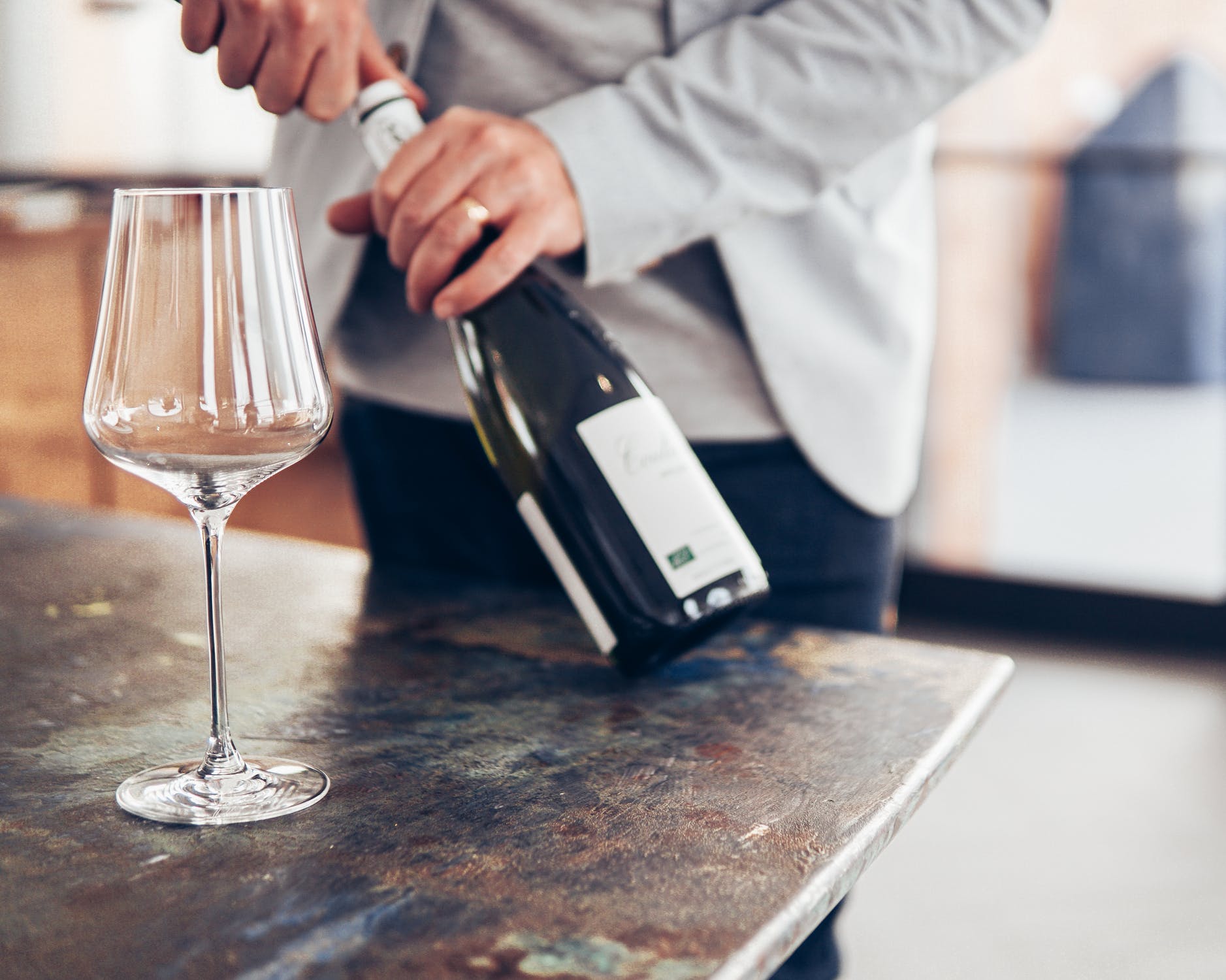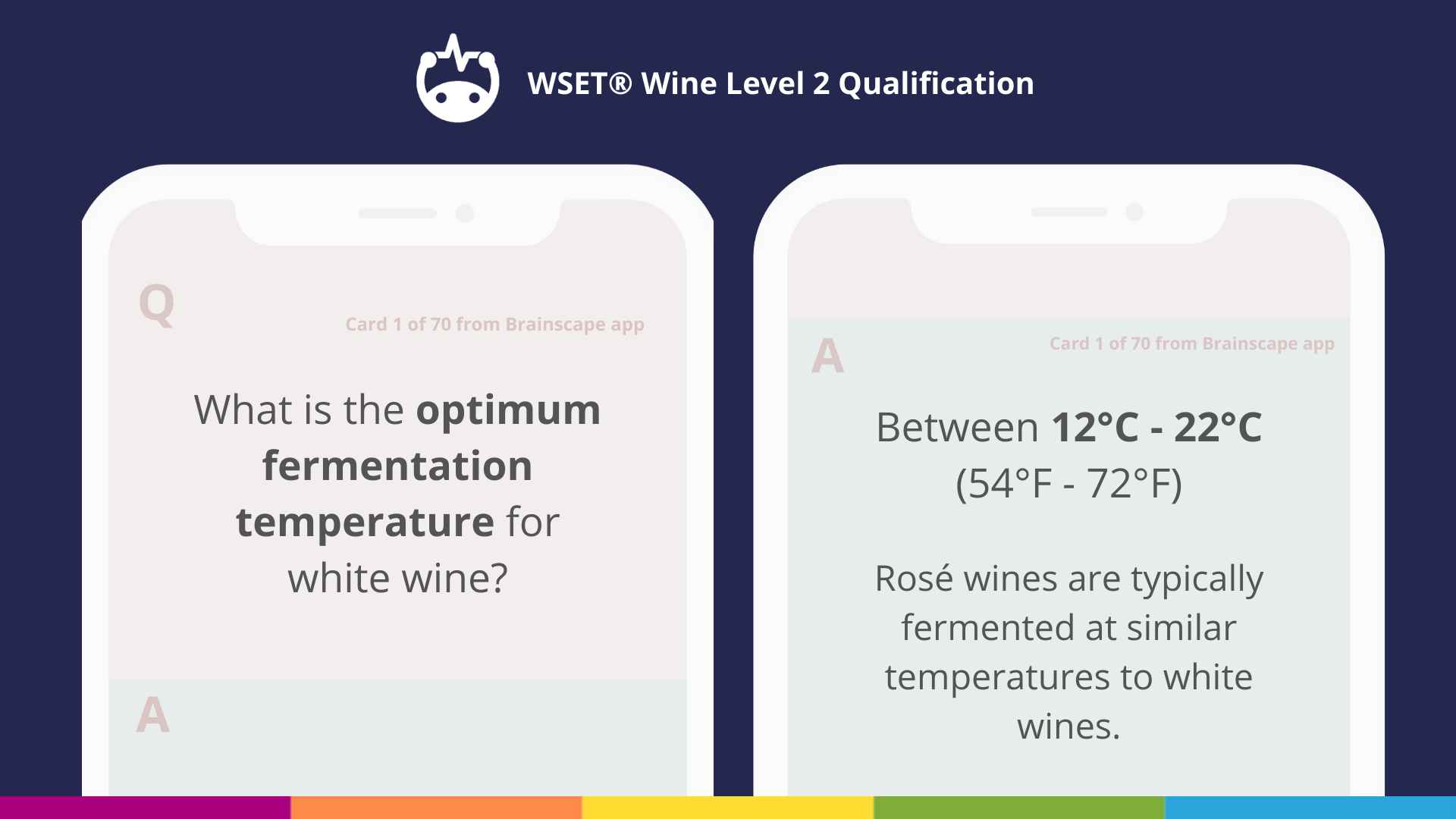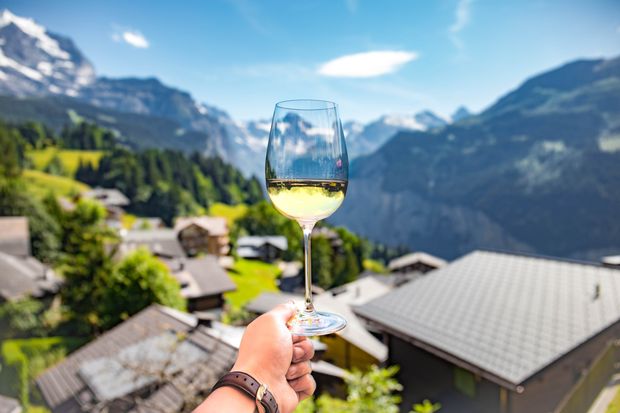Truth be told, you could go from cradle to grave without knowing a single stitch of information about wine. It’s doable but tragic ... plus, you’d be missing out on all that wonderment Ernest Hemingway waxed lyrical about:
“Wine is one of the most natural things of the world that has been brought to the greatest perfection, and it offers a greater range for enjoyment and appreciation than, possibly, any other purely sensory thing.”
The unfortunate reality is that the world of wine has a reputation for being ... well, complicated. And maybe just a little unapproachable.
We’re going to change that TODAY.
Being wine lovers with a passion for education, the team here at Brainscape put our noggins together to curate a wine guide that contains the most essential basic wine knowledge.
The “need to know” facts we present to you here are for anyone and everyone, whether you’re embarking upon a formal education with a WSET course in wine, or just want the necessary toolkit to sound smart when ordering wine. We cover the most important things you need to know about wine:
- How to taste and assess wine
- The principal grapes of the world
- The principal grapes of your country / region
- How wines are named
- How to store your wine properly
- The temperatures at which to serve different wines
- What glass should I serve wine in?
- Knowing when to send wine back
- The basic rules for pairing wines with foods
- What does vintage tell you about a wine?
But before we launch into those facts, let’s answer the question asked by cretins, I mean, wine novices, the world over …
Why should I know anything at all about wine?
“Nothing makes the future look so rosy as to contemplate it through a glass of Chambertin.” ― Napoleon Bonaparte
The point of having a bit of wine knowledge is elegantly simple. It’s to be able to choose the perfect wine for your budget, occasion, and meal. And THIS is important because the right wine will elevate the dining experience tremendously, without sending you home feeling like you’ve been sucker punched in the wallet.
Our goal with this introductory wine guide is to equip you with the essential knowledge you need to make smart wine choices. Oh, and if you’re interested in taking your wine knowledge even further, check out Brainscape’s awesome collection of expert-curated wine flashcards:
- Wine Appreciation
- WSET level 1 (introductory)
- WSET level 2 (beginner to advanced)
- WSET level 3 (advanced)
So, with that said, let’s get poppin’! Here are the 10 things everyone should know about wine.
1. How to taste and assess wine
“Beer is made by men, wine by God.” ― Martin Luther, circa 1500s
Your senses are the conduits through which your favorite wines will be discovered and important experience accrued. As such, the first step in your wine journey should be learning how to taste and assess the quality of wine:
- Look at the wine against a white piece of paper or table cloth (do not hold it up to the light). SEE its color and color intensity. For example: is it a bright ruby red visible to the core? Or a rich purple with an opaque centre?
- Swish the wine in the glass and SMELL, paying attention to any fruit notes and then floral, herbal, and spicy aromas.
- TASTE the wine, concentrating on its spectrum of flavors. Try to discern its acid (tartness—makes your mouth water), alcohol (heat felt on the palate, sinuses, and chest—like when you take a shot of tequila), sweetness, and tannins (dries your mouth out).
- FEEL the wine in your mouth. Is it light or does it have weight? Is it smooth and velvety or bright and fresh? Does it leave your mouth luxuriously coated or feeling like you’ve gargled with paint stripper?
At first, this may feel difficult. Picking apart what essentially “tastes like wine” can not only feel overwhelming but also a shade pretentious.
It’s not.
Besides, you’ve got to start somewhere. And learning the methodology to appraise wines will elevate and accelerate your learning journey!
Check out Brainscape’s flashcards on how to properly taste and assess wine. You might also consider downloading a wine app to guide you through the process, so definitely check out our top selection of top wine apps!
2. The principal grapes of the world
Your next step is to start learning about the world’s chief grape varieties and the very basic characteristics of the wines they produce.
The goal?
To learn that, for example, Cabernet Sauvignon is a dark ruby red wine that’s full bodied. On the other hand, Sauvignon Blanc is a medium bodied white wine. This alone will inform you when choosing a wine to go with your meal.
With time and tasting experience you’ll also learn that Cabernet Sauvignons have dark fruit flavors like plum, black cherry, and blackberry and aromas of warm spice, vanilla, black pepper, tobacco, and leather. And you’ll learn that Sauvignon Blancs typically have bright fruit flavors like lime, green apple, passion fruit, and white peach and heady, herbaceous and citrus aromas like zesty lime, green pepper, and fresh-cut grass.
For quick reference, here are 16 of the world’s principal grape varieties you should become acquainted with:
Red wines
White wines
For even more exciting grape varieties, check out Brainscape’s WSET Level 2 flashcard collection.
3. The principal grapes of your country / region
Now, depending on where in the world you come from, the key cultivars I mentioned in the previous point will be different. For example, in the USA, the four predominant RED wines you’ll encounter are Cabernet Sauvignon, Pinot Noir, Merlot, and Zinfandel. In Italy, however, you’ll come across Sangiovese, Nebbiolo, Barbera, and Montepulciano.
Find out what the principal wine grapes in your region are and start exploring those wines, learning first and foremost about what color they are (red or white) and then about the styles in which they’re made and their typical aromatic and flavor profiles. Once you’re familiar with those, you can start branching out to wines from other regions.
Pro Tip: Using pen and paper, a wine app, or even Brainscape’s flashcards, keep a record of the wines you try and their basic characteristics. You’ll learn so much quicker if you’re able to refer back to your notes on the cultivars and wines you’ve tried before.
4. How wines are named

The function of the wine label is to tell you everything you need to know about the wine so that you can make your buying decision. The only thing is ... the information on the wine labels tends to be written for people who know about wine, which can be confusing for people who don’t.
So, here’s what you need to know:
In many non-European countries (like the USA, Australia, Chile, New Zealand, and South Africa, etc.) the wines are usually named after the estate AND the grape from which they’re made. For example:
- Château Montelena Chardonnay (California, USA)
- Lanzerac Pinotage (Stellenbosch, South Africa)
- St Hugo Shiraz (Barossa Valley, Australia)
If the wine is a blend of different varieties, the bottle will mention the respective percentages that went into it so that you can get an idea of what the wine tastes like. (This is where our earlier recommendation to learn the world’s principal wine grapes and the basic characteristics of the wines they produce will come in handy!)
In many European countries, however, wines are named after the geographic region, village, or even vineyard from which they come. For example:
- Champagne is a wine region in northeastern France
- Chianti is a region of central Tuscany, Italy
- Ribera del Duero is a Spanish wine region located in the country's northern plateau
In addition to being named after the region from which they come, many of these wines will likely carry the name of their producer or estate so that you know their exact provenance. For example: Taittinger is a French wine family who are famous producers of Champagne; hence, their wine is called “Taittinger Champagne.”
This unfortunately adds a layer of complexity to things. You see, while wines from, for example, Burgundy in France are called “Burgundies”, European wine labels typically DON’T tell you what grape varieties go into crafting these wines.
The wine fact you’ll need to learn is that red Burgundies are made from 100% Pinot Noir and white Burgundies, Chardonnay. Without exception. It’s literally written into their law.
Similarly:
- Chablis makes expressive, strictly 100% Chardonnays,
- The Sauternais region is known for its sweet wines (Sauternes) made from Sémillon, Sauvignon Blanc, and Muscadelle grapes, and
- Bordeaux makes delicious, full-bodied red blends of Merlot, Cabernet Sauvignon, Cabernet Franc, Petit Verdot, and Malbec.
All of these wines are named after the French regions from which they originate. Your task is to remember what it means when a wine is called a Burgundy or a Bordeaux and roughly what to expect in terms of body and flavor characteristics.
Sure, that’s a whole lot to learn! But you will master it all with time and steady dedication to drinking wine.
I know ... what a tall order!
5. How to store your wine properly
One of the most popular, yet grievously incorrect places people store their wine is in the kitchen. I even had a friend who had a mini-wine rack on their kitchen counter next to their stove. I wanted to garrot them.
The golden rule of storing wine, whether it’s for next month or next decade, is to keep it somewhere (1) cool, (2) dark, and (3) away from temperature fluctuations, and (4) vibrations.
Do you now understand why RIGHT NEXT to the stove is the worst place you can keep wine?
Most wines today are made for early consumption so it’s not like you’re going to ruin the wine if you don’t adhere to these storage guidelines. Especially if you plan on drinking the wine that night or over the weekend. But if the longevity of your wine matters to you—even if you plan on keeping it for a few months—it really is a good idea to treat it right and store it somewhere consistently cool, dark, and still.
(Ever wonder how to buy wine online? Because we have some nifty tips and tricks to finding bargains and deals)
Pro Tip: Wine bottles with corks in them should be stored on their side so that the cork can remain moist and sealed. Wines with screw caps can be stored upright.
6. The temperatures at which to serve different wines
The rule of thumb is this:
- Full-bodied red wines, like Cabernet Sauvignons or Bordeauxs are served cool: between 17˚C and 20˚C (63˚F and 68˚F)
- Lighter style red wines, like unoaked Pinot Noirs or Gamays, are served chilled: between 10˚C and 17˚C (50˚F and 63˚F)
- More bodacious white wines, like oaked Chardonnays, are served chilled: between 9˚C and 15˚C (48˚F and 59˚F)
- Lighter style white wines, like crisp Sauvignon Blancs or Pinot Grigios, are served even chillier: between 7˚C and 12˚C (45˚F and 54˚F)
- Sparkling and dessert wines, like Champagne or Sauternes, are served ice cold: between 5˚C and 7˚C (40˚F and 45˚F), which is technically not ice cold but you get the point.
Oh, and if degrees Celsius in a wine guide confuses you, get used to it! Global wine organizations like the Wine & Spirits Educational Trust (WSETⓇ) teach their curriculums in metric units.
Should I add ice to my wine?
If you’re drinking an inexpensive wine and want to get it cold in a hurry, sure! But if you’re drinking a fine wine, you DON’T want to dilute its glorious complexities with something as pedestrian as water. Rather, chill it beforehand or even pop it into the freezer for 15 minutes.
Alternatively, you can use reusable ice cubes, which are made from acrylic or stone. These will freeze and keep your wine cool without shedding water. And if you’re feeling real fancy, freeze some grapes and use those as edible ice cubes!
7. What glass should I serve wine in?
Frankly, you could serve wine in a paper cup if this isn’t important to you. But if you want to get the most out of a wine, the right glassware can really (and quite perceptibly) enhance the aromatic qualities of the wine, how it flows into the mouth and, therefore, how you perceive its texture and flavor characteristics.
This may sound pedantic but it is actually a thing. In fact, it is such a thing that glassware companies like Riedel have specifically engineered shaped wine glasses for particular varieties.
It’s definitely not necessary to own such expensive glassware (although a girl can dream). But if you do want to zhuzh up your wine service, you can do it simply by purchasing larger wine glasses with broader bowls for red wines and glasses with smaller, narrower bowls for white wines.
And, of course, you can buy flutes for champagne or sparkling wine. The smaller surface area exposed to air is intended to keep the wine bubbly for longer.
8. Knowing when to send wine back

You’re probably new to wine ... so you’re still learning to trust your palate. That can make it hard to speak up and say something if the wine you’ve chosen smells like a eau de feral animal or would serve better as a vinaigrette on your salad.
But here’s the thing: your nose doesn’t lie. If the wine smells and/or tastes unpleasant or strange—so much so that you don’t want to drink it—then send it back. This is not what you were hoping for. And if you’re paying good money for it, you have every right to ask for something different.
This happens a lot with wine served by the glass, by the way. Oftentimes, the bartender will pour a glass from a bottle he or she opened yesterday (or even the day before) and the wine has become oxidized. This translates as a loss of joie de vivre, making the wine taste flat, lifeless, and even a little sour.
Be polite about it, but send the glass or bottle back. Even better, when you order the glass of wine, kindly request that they open a fresh bottle for you (and then stalk your server to the bar to make sure they honor your request ... just kidding).
For even more guidance on how to tell if your wine would better serve as drain cleaner fluid, check out Brainscape’s Wine Appreciation deck on Buying, Storing, & Serving Wine.
9. The basic rules for pairing wines with foods
Pairing the right wine with your meal allows the wine’s complexity and fruit flavors to soar, transforming the dish AND the wine into something even more delicious and enjoyable. On the other hand, pairing the wrong wine with food can make the wine taste bitter or sour. So there is much at stake, particularly if you’ve ordered an expensive wine off the menu.
The widely-accepted rule of thumb is that white wines go with lighter dishes and white meats, while red wines go with stronger-flavored foods and red meat dishes. The problem is, this “rule” is so beginner level it keeps wine lovers from experiencing the utter glory that is a Pinot Noir and grilled salmon pairing, or a Gewürztraminer and Thai coconut curry.
OUR wine-and-food guidelines are:
- The wine should be at least as acidic as the food
- The wine should be sweeter than the food, especially with the dessert course
- The wine should have the same flavor intensity as the food
- Red wines pair best with heavy meats, like beef and lamb
- White wines pair best with lighter meats, like fish and chicken
- Acidic wines are best balanced with fatty meals
- The wine should never overpower the food and vice versa
For more on key food-and-wine pairing principles, check out Brainscape’s Wine Appreciation flashcards on Wine & Food Pairing.
10. What does vintage tell you about a wine?
Vintage is essentially the year in which the wine grapes were harvested.
Why does this matter? Well, first of all, it tells you how old a wine is, which, depending on the wine, can tell you whether to drink it now or put it down for further aging.
Knowing the vintage of a wine is also an indicator of its quality. This is because some vintages featured the perfect weather conditions for grape growing and ripening. And the result of this is that the wines made that year (in that particular location) tend to be of a superior quality.
Are older wines better quality?
Not necessarily! Not all wines are built for longevity and while a quality Burgundy may reach its crescendo in 5, 15, or even 50 years, an everyday-drinking Pinot Grigio is probably not meant to sit on your wine rack for more than a year. Similarly, some wines made for some aging may peak after 10 years and then steadily decline thereafter. To know when you should drink a wine, refer to the label. This should tell you how long you can expect to keep it ... in ideal storage conditions, mind you!
What is a non-vintage wine?
A non-vintage or “NV” wine is one that is made from a blend of two or more years’ wines, and so it isn’t specific to any one vintage. Winemakers often do this when they’re looking to make a super consistent wine that changes little from year-to-year.
Bonus: How to make wine at home
Can we share a secret with you? Wine is easy to make. So easy, it can be done through accidental fermentation. HOWEVER. Decent wine is terribly difficult to make, especially from the confines of your own home. But if you pull it off, you'll not only have your own top-quality wine but you'll also get to brag to your friends for the rest of your life. Do we have your attention?
Learn how to make wine at home with our ultimate guide.
And that’s everything you need to know about wine (for now)
There you have it: 10 things you need to know about wine, from the principal wine grapes of the world, the best glassware to use, and basic wine-and-food-pairing principles to the relevance of vintage.
If you dedicate yourself to learning the key facts laid out in this wine guide you should be able to stride forth into your next restaurant or liquor store with oodles of confidence ... and the savvy to find the perfect bottle of wine for your next occasion! Or at least have the right questions to ask your sommelier or wine merchant.
If you’re hungry for more wine knowledge or need a super effective tool to help you learn the facts we’ve discussed here, check out Brainscape’s awesome collection of wine flashcards
- Wine Appreciation
- WSET level 1 flashcards (introductory wine appreciation)
- WSET level 2 flashcards (beginner to advanced)
- WSET level 3 flashcards (advanced)
- CMS Introductory Sommelier

